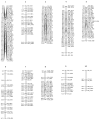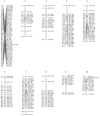Environmental and Genetic Factors Affecting Apospory Expressivity in Diploid Paspalum rufum
- PMID: 34685909
- PMCID: PMC8537111
- DOI: 10.3390/plants10102100
Environmental and Genetic Factors Affecting Apospory Expressivity in Diploid Paspalum rufum
Abstract
In angiosperms, gametophytic apomixis (clonal reproduction through seeds) is strongly associated with polyploidy and hybridization. The trait is facultative and its expressivity is highly variable between genotypes. Here, we used an F1 progeny derived from diploid apomictic (aposporic) genotypes of Paspalum rufum and two F2 families, derived from F1 hybrids with different apospory expressivity (%AES), to analyze the influence of the environment and the transgenerational transmission of the trait. In addition, AFLP markers were developed in the F1 population to identify genomic regions associated with the %AES. Cytoembryological analyses showed that the %AES was significantly influenced by different environments, but remained stable across the years. F1 and F2 progenies showed a wide range of %AES variation, but most hybrids were not significantly different from the parental genotypes. Maternal and paternal genetic linkage maps were built covering the ten expected linkage groups (LG). A single-marker analysis detected at least one region of 5.7 cM on LG3 that was significantly associated with apospory expressivity. Our results underline the importance of environmental influence in modulating apospory expressivity and identified a genomic region associated with apospory expressivity at the diploid level.
Keywords: Paspalum rufum; apospory expressivity; diploid level; environment; inheritance.
Conflict of interest statement
The authors declare no conflict of interest. The funders had no role in the design of the study; in the collection, analyses, or interpretation of data; in the writing of the manuscript, or in the decision to publish the results.
Figures








Similar articles
-
Differential Epigenetic Marks Are Associated with Apospory Expressivity in Diploid Hybrids of Paspalum rufum.Plants (Basel). 2021 Apr 17;10(4):793. doi: 10.3390/plants10040793. Plants (Basel). 2021. PMID: 33920644 Free PMC article.
-
Analysis of variation for apomictic reproduction in diploid Paspalum rufum.Ann Bot. 2014 Jun;113(7):1211-8. doi: 10.1093/aob/mcu056. Epub 2014 Apr 16. Ann Bot. 2014. PMID: 24739230 Free PMC article.
-
Heterochronic reproductive developmental processes between diploid and tetraploid cytotypes of Paspalum rufum.Ann Bot. 2019 May 20;123(5):901-915. doi: 10.1093/aob/mcy228. Ann Bot. 2019. PMID: 30576402 Free PMC article.
-
Harnessing apomictic reproduction in grasses: what we have learned from Paspalum.Ann Bot. 2013 Sep;112(5):767-87. doi: 10.1093/aob/mct152. Epub 2013 Jul 17. Ann Bot. 2013. PMID: 23864004 Free PMC article. Review.
-
Reproductive Systems in Paspalum: Relevance for Germplasm Collection and Conservation, Breeding Techniques, and Adoption of Released Cultivars.Front Plant Sci. 2019 Nov 21;10:1377. doi: 10.3389/fpls.2019.01377. eCollection 2019. Front Plant Sci. 2019. PMID: 31824520 Free PMC article. Review.
Cited by
-
Apomixis and the paradox of sex in plants.Ann Bot. 2024 Jun 7;134(1):1-18. doi: 10.1093/aob/mcae044. Ann Bot. 2024. PMID: 38497809 Free PMC article. Review.
-
Variation of Residual Sexuality Rates along Reproductive Development in Apomictic Tetraploids of Paspalum.Plants (Basel). 2022 Jun 21;11(13):1639. doi: 10.3390/plants11131639. Plants (Basel). 2022. PMID: 35807591 Free PMC article.
-
Apomixis: oh, what a tangled web we have!Planta. 2023 Mar 31;257(5):92. doi: 10.1007/s00425-023-04124-0. Planta. 2023. PMID: 37000270 Free PMC article. Review.
References
-
- Kumar S. Epigenetic control of apomixis: A new perspective of an old enigma. Adv. Plants Agric. Res. 2017;7:10-15406. doi: 10.15406/apar.2017.07.00243. - DOI
-
- Toenniessen G.H. Feeding the world in the 21st century: Plant breeding, biotechnology, and the potential role of apomixis. In: Savidan Y., Carman J.G., Dresselhaus T., editors. The Flowering of Apomixis: From Mechanisms to Genetic Engineering. CIMMYT, IRD, European Commission DG VI (FAIR); Mexico City, Mexico: 2001. pp. 1–7.
-
- Whitton J., Sears C.J., Baack E.J., Otto S.P. The dynamic nature of apomixis in the angiosperms. Int. J. Plant Sci. 2008;169:169–182. doi: 10.1086/523369. - DOI
Grants and funding
LinkOut - more resources
Full Text Sources
Miscellaneous

